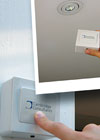

An ultra-simple pairing technique for ZigBee-enabled appliances has just been demonstrated at the ZigBee Open House event in Chicago, by Cambridge Consultants.
The technique allows end-users to configure ZigBee wireless networks in real world applications - such as determining which lights are controlled by which switch - without any tools or training. It works by exploiting the RSSI (received signal strength indication) data made available by ZigBee silicon solutions.
Any ZigBee enabled device - such as a light switch - simply needs an additional pushbutton to initiate the pairing process. To configure the network, the user holds the device close to the chosen ZigBee-enabled appliance, and presses the button. A proprietary pairing algorithm in the ZigBee chip then compares the RSSI data received by each node to determine the closest node in the network. The approach eliminates the need for a complex network configuration tool such as a PC, as well as the need and expense of a trained operator.
The pairing process can be repeated with other devices to select a group of appliances, and operates in a similar reverse fashion to clear pairings. The algorithm, developed by Cambridge Consultants, automatically manages issues such as the screening effect of a user's body or an obstacle between the nodes. Once paired, a controlling device can be located anywhere on the network.
The technology is equally applicable to individual components such as a light switch, or multifunction controllers such as handheld terminals. The algorithm code is very compact, and can be easily put on a ZigBee chip. The total bill-of-materials for adding the solution is a few cents worth of hardware for the pushbutton, and a few kilobytes of code space for the additional firmware.
"In ZigBee application areas such as building automation, end users require ultra-simple methods of selecting and controlling networked devices," says Paul Williamson of Cambridge Consultants. "This 'click and pair' technique provides a very low-tech, consumer-friendly way of configuring a network. After all, the commercial take-up of a radical new technology like ZigBee depends heavily on how easy it is for consumers to pick up and use."
Building and home automation is one major area where Cambridge Consultants see applications for this technology. In addition to allowing switches to pair with lights, it can be used for configuring HVAC systems into zones to match office space configurations, or to pair smoke alarms with fire door release mechanisms, emergency lights, sprinklers, etc. Other applications can also be found in the industrial automation arena - another major target for ZigBee technology.

© Technews Publishing (Pty) Ltd | All Rights Reserved